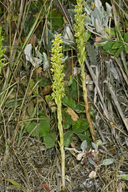notes ========== Context ==========
The five photos of this series show plants found in coastal scrub habitat on the bluffs above the ocean near Franklin Point. To see the highest resolution available for each photo, click the 'full size' link directly above each photo's thumbnail (at upper left of the page)...and then click the image again after it loads. Unfortunately, the plants shown in this series were right along a well-used trail...and thus their somewhat viscid flowers were liberally splattered with dust kicked up by hikers. (Oh well...still beautiful & fascinating plants ;-).
========== Genus Name Ambiguities, References, and Species ID ==========
This is one of our native CA orchids, referred to the genus Piperia by most CA botanists...though some molecular-oriented taxonomists have advocated treating Piperia as a 'section' within the genus Platanthera (cf. Bateman et. al. (2003)). Members of Piperia were originally segregated from the larger genus Platanthera by Rydberg in 1901...and various past authors had referred them to the genus Habenaria (e.g. E. L. Greene, W. L. Jepson, and others). A detailed revision of Piperia appeared in Ackerman(1977).
Note that for (resupinate) orchid flowers, the lower perianth lobe is usually enlarged and/or modified and is called the 'lip' (or 'labellum'); the upper lateral lobes are called the 'petals'; and the other three (outer) perianth lobes are called the 'sepals' (e.g. see here). The lip in Piperia extends posteriorly into an elongate nectar spur, and the known pollinators for members of the genus are moths that pick up and transfer pollinia on their long proboscises while nectaring in the hours after dusk.
The CalFlora web page here indicates Piperia records in the vicinity of Franklin Point for both P. michaelii and P. elegans. Below are some resources for the ID here:
Keys to Piperia species: Jepson eFlora; Flora of North America; Ackerman(1977) pg. 261; Rydberg(1901) Diagnosis for P. michaelii: Jepson eFlora; Flora of North America; Ackerman(1977) pp. 265-266; Rydberg(1901) Diagnosis for P. elegans: Jepson eFlora; Flora of North America; Ackerman(1977) pp. 266-267; Rydberg(1901)
The simplest distinguishing characters for the two coastal species found near Franklin Point are as follows:
• P. michaelii has flowers pale yellowish-green, with the lip (and to a lesser extent the petals) shorter and more deltate (i.e. wider basally) than in P. elegans. • P. elegans has flowers whitish (and perhaps a bit of pale green baso-medially on some perianth lobes), with the lip and petals longer and more lanceolate (i.e. narrower basally) than in P. michaelii.
P. michaelii: 




P. elegans: 




Coastal populations of both species are noted for having stouter stems, more numerous stem bracts, and denser inflorescences than do inland populations.
For interests sake, below are some references on: 1) orchid pollination; and 2-4) orchids seeds and their fascinating obligate relationship with mycorhizal fungi for germination:
1) Orchid Pollination Biology (2015) 2) Germination and seedling establishment in orchids: a complex of requirements (2015) 3) Seedling mycorrhiza: a discussion of origin and evolution in Orchidaceae (2014) 4) History of orchid propagation: a mirror of the history of biotechnology (2009)
========== A Non-Botanical Aside ==========
Franklin Point is midway between nearby Pigeon Point and Año Nuevo Island...all three locales are associated with shipwrecks in the late 1800's (cf. also lecture video here), and the latter two locales are associated with lighthouses (see Pigeon Point, Año Nuevo). I was listening to some music while writing-up these remarks for that day's visit to Franklin Point when a song came on whose title & lyrics seemed to connect in my mind with the locale (allowing for some confounding between 'point' & 'tower' and 'light' & 'bell' ;-). For fun, here's a substitute verse apropos to events from that trip:
At Franklin's Point the four winds sleep Four red-billed oystercatchers peep
Orchid seed in the sand and wind
May the four winds blow you home again
_________________________________________________________














